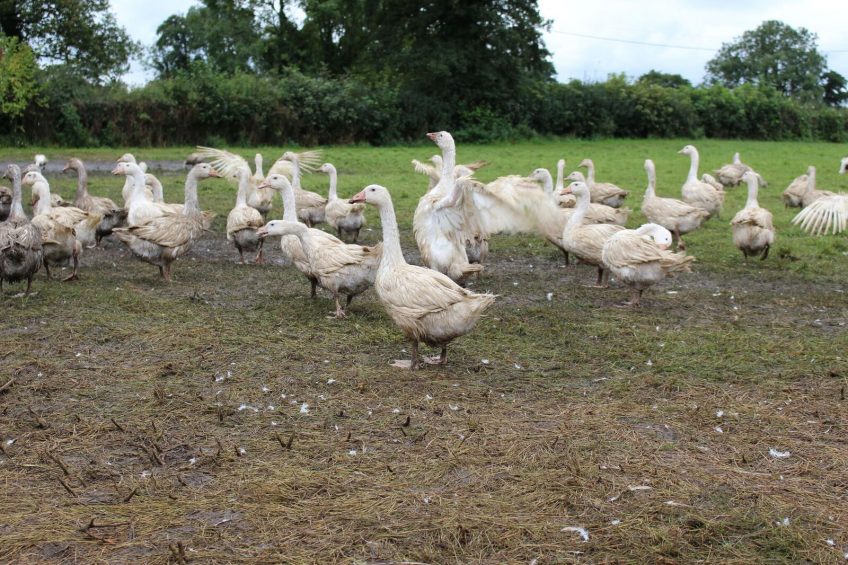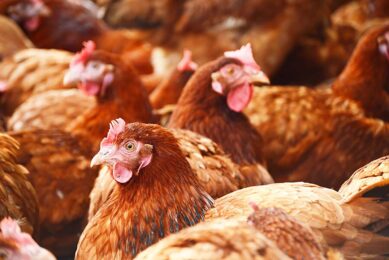Poultry enterprise makes the most of premium production

How do you go from running a 20,000-laying hen operation and an 80-cow dairy herd to producing poultrymeat for some of the top Michelin star chefs in the country? Sarah Alderton visited Johnson and Swarbrick poultry farm in Goosnargh, Preston, to find out.
Goosnargh near Preston, Lancashire, has had its name put firmly on the foodie’s map thanks to poultry producers Johnson and Swarbrick of Swainson Farm.
Prior to 1985 the farm, which was run by step-brothers Reg Johnson and Bud Swarbrick, was made up of a 20,000-laying hen operation and an 80-cow dairy herd.
But a desire by Reg to diversify led to him meeting up with restauranteur and celebrity chef Paul Heathcote, who set him the challenge of producing a British corn-fed chicken to rival the French.
Within a year and after several tweaks to the diet to perfect the flavour and colour of the meat, the business had started to change.
‘A happy bird is a tasty bird’
From there the hens and dairy herd made way for a farm focused on meat production.
Today the business is processing 2,200 ducks a week of which some 500-600 are corn-fed. About 2,000 corn-fed chickens are also processed each week through their on-farm processing plant. About 1,500-2,000 geese are also produced for the Christmas market as well as some turkey.
Customers consist of some of London’ top chefs including the likes of Michel Roux Junior, Marco Pierre White and Raymond Blanc.
With so many customers in London, they personally deliver their produce into London as well as within a 100-mile radius of the farm. A courier service is used to deliver orders elsewhere across the UK. Produce is also sold through supermarket chain Booths.
The motto of the farm is ‘a happy bird is a tasty bird’, according, Reg’s daughter Kara Johnson, who was speaking at the British Goose Producers annual farm walk last month (21 September).
Ms Johnson now runs the business alongside Bud and his son Adam Swarbrick, following the sudden death of Reg in 2015.
“Reg was a poultry legend and we want to continue to drive forward the business in his honour,” she says.

Chickens and ducks
All birds are reared to high welfare standards. Chickens and ducks are brought in as day-old chicks and reared in large barns.
They are bedded on miscanthus grass at least twice a week, with 11.3ha (28 acres) grown for bedding. It is stored in an Ag Bag and then dried out in a barn for 3 to 4 weeks, prior to being chopped through a forager.
A biomass boiler was installed in April 2016 to reduce heating costs and is used to heat many of the sheds. Miscanthus grass is used to feed the boilers, as well as wood chip.
Chickens are grown at a slower rate; over 8 weeks and are fed a finisher meal in pan feeders consisting of; 500kg maize, 250kg of wheat, 150kg of hipro soya, 2 gallons of soya oil and some vitamin and mineral supplementation. Corn-fed ducks are fed the same ration.
Ms Johnson says the market is there for corn-fed poultry. “Customers are demanding more corn-fed, as the meat is more tender and flavoursome.”
Wheat-fed ducks are fed a finisher meal in troughs made up of 500kg wheat, 200kg maize, 250kg hipro soya, 2 gallons of soya oil, 12kg of a fat pre-mix and vitamins and minerals.
All feed is mixed on the farm with up to 30t mixed a week. Bud says there are several benefits from mixing their own feed.
Farm facts Swainson Farm, Goosnargh, Lancashire
•Founded by step-brothers Reg Johnson and Bud Swarbrick
• Directors now include Reg’s daughter Kara, Bud’s son Adam Swarbrick and Bud, due to the premature death of Reg in 2015
• Started producing corn-fed chicken and duck in 1980’s
• Produce about 2,200 ducks a week of which, 500-600 are corn-fed
• Process 2,000 corn-fed chicken a week
• Have their own on-site processing plant
• About 1,500-2,000 geese are also produced for the Christmas market as well as turkey
• Employ 25 people, with many of the workers Polish
• 3 years ago, invested in a feather processing unit and export about 30t of duck feathers and 5t of goose feathers a year to Germany.
“It is something we have always done and as well as saving money, we also know exactly what is going into the ration and we are also able to tweak, if necessary,” he says.
They work with nutritionist Ian Hollows of Target Feeds, Shropshire, to devise the starter, grower and finisher rations.
Goosnargh duck is a cross between the Aylesbury and Peking, giving the best meat to bone balance with a good breast weight. They are usually 56-days old at slaughter.
Ducks are killed in the afternoon and are then left to hang overnight, which allows the taste to develop. The next day they are processed and are dry plucked and dipped in wax, in order to prevent damage to the skin. Geese are processed in the same way. Chickens are processed on a different line and are wet plucked.
Ms Johnson says they don’t plan on changing anything with the chicken and duck production. “In honour of Reg, we want to continue rearing our birds in the same way. We have a niche product and we want to keep it that way. We still work with a lot of chefs who value our product,” she adds.
Goose considered a luxury product
Goose production is one of the farm’s relatively ‘new’ additions and began 10 years ago, after they saw popularity for goose for the Christmas market increasing.
Ms Johnson says: “Celebrity chefs have helped increase the popularity of the bird and it is viewed as a luxurious product. It has taken the food industry to a new level as they now have the accessibility and knowledge to cook it.”
Goslings are brought in at a day-old in June and are reared inside until they are fully feathered. When the time is right, they are let outside to graze a 1 hectare (3 acre) paddock during the day and are back inside bedded on miscanthus at night.
When inside they are fed a 20% protein starter diet consisting of wheat, hipro soya, soya oil and vitamins and minerals, with the protein dropping to 17-18% during the growing phase and 16% at finishing.
Bud says they don’t want the protein too high in the feed. “If the protein is too high then the birds will grow too fast for their legs. We want nice steady growth,” he states.
The aim is to finish birds anywhere from 4kg-7kg (8.8lb-15lb), when they are about 5 to 6 months old. This year they have changed the supplier of goslings as they are looking to produce a slightly bigger bird.
Adam says: “Some of our customers, particularly the restaurants want a bigger bird. We are now sourcing goslings from Daryn Williams, Madgett’s Farm, Chepstow.”
Once the birds are killed they are hung for a minimum of 12 hours before being plucked and waxed.

Feather production
The family have also established another company called AK Products. As Reg was always looking for new ideas and ventures to run alongside the farming business, when he heard Norfolk feather producer Michael Shingfield was coming out of production and was selling his feather washing plant, he went down to take a look.
So, in 2014 Reg bought the equipment and erected a new shed to house it, which cost about £80,000 in total.
They not only process feathers from their own ducks and geese, but they also source feathers from a handful of farmers. However, they will only source feathers that are from birds that have been dry plucked.
Adam explains: “Feathers from wet plucked birds would break down quicker as they start deteriorating straight away.”
They are processing about 30t of duck feathers and 5t of goose feathers a year. It can take about four months before they have a big enough load to export (8t minimum), with all feathers sold to Germany for high quality duvets and pillows.
Feathers are washed for 20-25 minutes and are then put through a tumble dyer. They are then dried at 120-130°C, which kills any bacteria, before being left to cool in a cooling box.
About 20-30% of the weight of duck feathers is lost as the big feathers are not used. These are recycled as bedding in the sheds.
Although the feather market was strong three years ago, it has died back 60% in the past 18 months.
Adam says: We used to get £2.25/kg for feathers, but it has dropped down to £1.20/kg and has been like that for the past 13 months. It is starting to pick up a bit now though,” he said.
Feathers are processed a couple of times a week by existing staff.
Join 31,000+ subscribers
Subscribe to our newsletter to stay updated about all the need-to-know content in the poultry sector, three times a week. Beheer
Beheer








 WP Admin
WP Admin  Bewerk bericht
Bewerk bericht